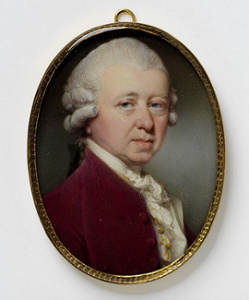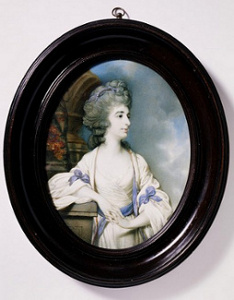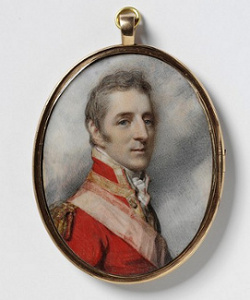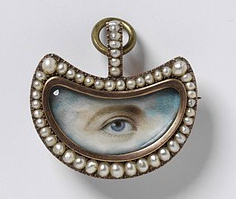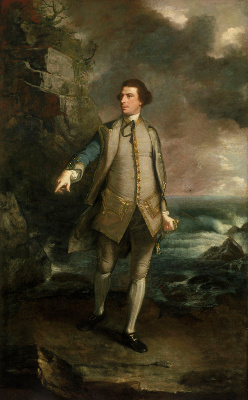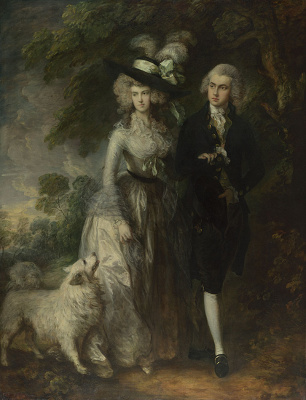|
over the last few decades, interdisciplinary approaches to the study of Jane Austen have produced a number of illuminating scholarly articles that discuss her works in relation to portraiture. Lance Bertelsen, for example, has described the way in which Austen’s descriptions of her characters’ physical appearance accord with the theories of representation that lie behind the work of contemporary portraitists. Janet Todd, on the other hand, has taken up Austen’s often quoted expression, “the little bit (two Inches wide) of Ivory on which I work with so fine a Brush,”1 a reference to miniature painting. Todd calls this Austen’s “aesthetic credo” (76) and goes on to show how Austen, having chosen an appropriately small canvas to work on, works as a miniaturist with words. In the course of their discussions, Bertelsen and Todd refer to Austen’s effective use of portraits in such works as Sense and Sensibility (1811) and Pride and Prejudice (1813), while Peter Sabor has analyzed the role of portraits in Persuasion (1817).2
Often oval-shaped, a miniature portrait is only about 2 to 3 inches wide, while a rectangular life-sized full-length portrait is frequently as large as 8 feet high and 5 feet wide. The former is painted in watercolor on ivory, the latter in oil on canvas. These two kinds of portrait occupied, each in its own way, a special place in eighteenth- and nineteenth-century English life.
Many English novelists besides Austen made use of portraits in their novels. For instance, a miniature portrait appears at a critical moment not only in Sense and Sensibility and Persuasion, but also in novels as various as Ann Radcliffe’s The Mysteries of Udolpho (1794), Mary Shelley’s Frankenstein (1818), and Charlotte Brontë’s Jane Eyre (1847). Similarly a full-length portrait plays a crucial role in Pride and Prejudice as well as in, to cite a few examples, Thomas Hardy’s Tess of the D’Urbervilles (1891) and Oscar Wilde’s The Picture of Dorian Gray (1891).3
Miniature portraits
The art of miniature portrait painting flourished from the Elizabethan period and in the last quarter of the eighteenth century, the number of miniaturists greatly increased due to the patronage of the gentry and the rising middle class. By this time, ivory had replaced vellum as the base for paintings. As one can see below in Jeremiah Meyer’s Unknown Man (c. 1780, 7.6 x 5.6 cm), Richard Crosse’s Mrs. Siddons (1783, 17.4 x 13.3 cm), and Richard Cosway’s Arthur Wellesley (1808, 7.1 x 5.6 cm), artists exploited “the pleasing effect of the luminous ivory showing through the paint” (Coombs 86). A miniature was commissioned to commemorate some occasion or to give as a token of love to someone special. Treasured as jewels, they were framed and hung in a room or set in a locket and carried on one’s person. A trade card for Albin Robert Burt around this time shows that he charged 3 to 9 guineas for a miniature on ivory (Coombs 98).
Fashions related to miniatures came and went. In the middle of the eighteenth century, they were worn, for example, in discreet wrist bracelets; later a showy necklace variety appeared. Jane Austen’s aunt, Philadelphia Hancock’s miniature (c. 1768), painted by John Smart, is less than 1 inch (2 cm) in width and set in diamonds.4 Towards the end of the eighteenth century, there developed the fashion of arranging hair ornaments in the reverse side of miniatures.5 There was also a freakish art that lasted for a very short period—the art of the so-called “eye miniature.” Unfortunately, neither the artist nor the sitter of this small (1.2 x 2.2 cm), early nineteenth-century eye miniature are known.6
As Patrick J. Noon explains,
[T]he traditional appreciation of miniatures as jewellery or objects of personal adornment and private emotions held for the better part of two centuries. The preference for the oval shape, the placement of bits of hair, often elaborately arranged or plaited, in the backs of late eighteenth-century frames, and the miniature depiction of single human eyes—a curious fad of the period but one that primarily catered to amative or simple fraternal sentiments—all reflect in their fashion this long-standing conception of the miniature’s special function and value. (196)
By the end of the nineteenth century, the art of miniature painting had died out, replaced by the art of photography.
Full-length portraits
If miniature portraits were “objects of personal adornment and private emotions,” formal, life-sized, full-length portraits asserted high social standing. Large family portraits of many generations hung in the gallery of a country-house impressed the visitors with the power and glory of the family. In the middle of the eighteenth century, a successful London artist would charge about 24 guineas for a full-size portrait, while Reynolds is said to have demanded 200 guineas at the height of his success (Vaughan 77). Indeed, only the very affluent could afford to commission a full-size portrait from such a renowned artist.
On commissioning portraits, clients consulted at the studio of the artist as to their costumes, postures, and so on. During the several sittings of several hours each, the artist engaged the sitters with suitable conversation while he observed them at their best. But he had to take some special measures at times, as William Vaughan humorously tells us: “There are stories of painters dancing round the studio with pale-faced ladies to heighten their complexion; and one, Francis Hayman, even entered into a bout of fisticuffs with a male sitter to work him up to a ruddy glow!” (41).
The sitter of such a painting was often idealized. Take, for example, Joshua Reynolds’s Captain, the Honorable Augustus Keppel (1752-53, 239 x 147.5 cm). On a canvas nearly 8 feet high and 5 feet wide, the naval commander Keppel is portrayed striding on the sea shore in a pose that resembles a Greek statue of a hero. The sky is heavy with dark clouds, and the sea stormy with crashing waves, while the light is beginning to stream in from the right top corner. Against the background full of dark-brown shadow, Keppel’s right hand stands out in white, catching the falling light.7 The hand expresses his power to overcome tempestuous situations either on the sea or the battlefield and to come out triumphant in all his glory.
Another example is Thomas Gainsborough’s The Morning Walk (1785, 236.2 x 179.1 cm).8 It portrays an elegant couple, William Hallett and Elizabeth Stephen, taking a stroll through woodland accompanied by a dog. The portrait was commissioned to celebrate the couple’s forthcoming wedding. Note that the colors of their costumes are in harmony with the landscape. As Michael Rosenthal puts it, William’s “sober black suit melts . . . on one side into the gloom of nature and, on the other, into the shaded side of [Elizabeth’s] diaphanous dress, which in turn corresponds in brilliance of tone to the bright clouds that dominate the landscape background” (239). In the age of sensibility when “nature was the touchstone,” this harmony proved their “exemplary character” (Rosenthal 239).
Frankenstein
Mary Shelley’s Gothic world may seem to be diametrically opposed to Jane Austen’s world of realism, but in both worlds a miniature appears. In Shelley’s Frankenstein, Austen’s Sense and Sensibility, and Pride and Prejudice each main character encounters a miniature of his or her “lover.”
In Volume 2, Chapter 8, of Frankenstein, the monster gets hold of a miniature of Caroline Frankenstein. He has just killed her youngest son, William, a brother of his creator and avowed enemy, Victor Frankenstein. But the miniature, which the monster has found on the dead body of William, the portrait of “a most lovely woman,” softens and attracts him. With great delight, he gazes on Caroline’s “dark eyes, fringed by deep lashes, and her lovely lips.” He presently remembers, however, that if she sees his hideous self, even her “air of divine benignity” will turn to “one expressive of disgust and affright” (138). Caroline’s miniature thus attracts yet enrages him.
The episode of Justine Moritz that follows is but a repetition of this scene. Going into a barn for shelter, the monster finds Justine, a servant of the Frankenstein family, fast asleep. He is again allowed to “gaze” on a woman, but unlike Caroline’s miniature, Justine is a woman in the flesh—young, healthy, and blooming. As Maurice Hindle puts it, the monster’s “sexual desires are aroused” (81). He softly approaches Justine, bends over her, and whispers: “Awake, fairest, thy lover is near—he who would give his life but to obtain one look of affection from thine eyes: my beloved, awake!” (139).
Shelley emphasizes the monster’s physical proximity to Justine. Justine, however, stirs and “a thrill of terror” runs through the monster, lest at waking she should “curse” and “denounce” him. In anger he swears, “[N]ot I, but she, shall suffer; the murder I have committed because I am forever robbed of all that she could give me, she shall atone.” Significantly, he uses Caroline’s miniature to shift his murder of William to Justine: he “place[s]” the portrait “securely in one of the folds of her dress” (139). This action—the monster’s insertion of the miniature into “one of the folds of her dress”—can be interpreted as a rape of Justine. The action foretells, in that sense, the violence he will inflict upon another woman—the rape-murder of Elizabeth Lavenza on the night of her wedding (Hindle 103-04). The miniature thus curiously links the three victims of the monster: William, Justine, and Elizabeth.
After William’s murder, his father writes to Victor: “William had teased [Elizabeth] to let him wear a very valuable miniature that she possessed of your mother. This picture is gone, and was doubtless the temptation which urged the murderer to the deed” (70). Although not in the way the father imagines, the mother’s miniature is associated with mischief. Her son, William, who has been wearing it, is mangled to death; her servant, Justine, who has been found in possession of it, is sentenced to death; her adopted daughter, Elizabeth, who originally owned it, is raped and murdered on her bridal bed. A miniature, a mother’s token of love, turns into a curse for those who carry it. In Frankenstein the monster produces horror by reversing the socially understood function of the miniature.
Sense and Sensibility
In Volume One, Chapter 22, of Sense and Sensibility, Elinor Dashwood is shocked to find a miniature of her lover Edward Ferrars in the hand of Lucy Steele. Having just been told by Lucy of her secret engagement to Edward and been totally incapable of believing it, Elinor wonders if Lucy might be talking of another man with the same name. It is then that Lucy brings out the miniature. She says, “‘To prevent the possibility of mistake, be so good as to look at this face. It does not do him justice to be sure, but yet I think you cannot be deceived as to the person it was drew for.’” Lucy shows off Edward’s miniature to her rival. Casually adding, “‘I have had it above these three years,’” she puts the miniature in Elinor’s hands. When “Elinor saw the painting, whatever other doubts her fear of a too hasty decision, or her wish of detecting falsehood might suffer to linger in her mind, she could have none of its being Edward’s face. She returned it almost instantly, acknowledging the likeness” (151).
Austen’s way of introducing Edward’s miniature is sudden and effective. In the midst of a tête-à-tête, which for Elinor has been highly nerve-wracking, Lucy brings out the miniature. The tension between the two shifts from a verbal to a visual one. Elinor is forced to look at her lover’s “face.” Like a photograph one might put in a present-day mobile phone, a miniature is portable. Lucy’s nasty trick may be likened to showing off to one’s rival an intimate photograph stored in a mobile phone. Elinor returns Edward’s miniature “almost instantly.” She cannot bear to look at it any longer.
Visual evidence is powerful. When Elinor is next shown a letter cover addressed to Lucy in Edward’s handwriting, she no longer doubts their engagement. She learns to her dismay that the ring which she had recently seen Edward wearing contains, not a piece of her hair as she had imagined, but a piece of Lucy’s. She feels deeply humiliated and groans with the knowledge that she will have no more power over her lover and that he will be bound in honor to Lucy.
Pride and Prejudice
If Elinor in Sense and Sensibility is forced to look at Edward’s portrait, Elizabeth Bennet, in Pride and Prejudice actively looks for Fitzwilliam Darcy’s portrait in the gallery of Pemberley. In Volume Three, Chapter 1, of the novel, Elizabeth encounters, as it were, three portraits of Darcy. She bursts into admiration when she sees Pemberley in full view—the edifice is, in a manner of speaking, a portrait of Darcy displayed in public. Within the house, she sees his miniature and a “‘finer, larger picture’” in “‘the gallery up stairs’” (274), apparently a formal family portrait of full size and length. While Elizabeth is seeing and observing, she is engaged in the act of listening not only to others, such as the housekeeper, Mrs. Reynolds,9 but also to her own inner voice, to form a fuller image of Darcy.
Let us start with the first portrait. Not wishing to encounter Darcy, Elizabeth visits Pemberley with the Gardiners, only after she has made sure of his absence. Pemberley, however, enthralls her. The park is “very large,” contains “great variety of ground” and “a beautiful wood” that stretches “over a wide extent.” Ascending for “half a mile” in a carriage, the party reaches “the top of a considerable eminence.” From their vantage point, they can view the house as though they are looking at a large painting.
[The] eye was instantly caught by Pemberley House, situated on the opposite side of a valley, into which the road with some abruptness wound. It was a large, handsome, stone building, standing well on rising ground, and backed by a ridge of high woody hills;—and in front, a stream of some natural importance was swelled into greater, but without any artificial appearance.
Seeing a magnificent view spread before them, “[t]hey were all of them warm in their admiration” (271).
The vastness of the estate, the well kept grounds and stately house all speak of the power and wealth of the family. The nicely maintained balance between natural beauty and man-made art proves Darcy’s good taste. Pemberley further symbolizes Darcy in that he himself is blessed by both nature and art—by both birth and education. In admiring Pemberley, Elizabeth and her party are admiring, as it were, a portrait of Darcy presented in open view to the public. As Duckworth argues, Darcy’s estate is “a natural analogue of his social and moral character” (123).
Darcy’s second portrait is within the house. It is a part of a miniature collection that adorns the late Mr. Darcy’s favorite room. Note, however, that out of this collection, Austen first makes use of Wickham’s miniature. When the party reaches the room, Mrs. Gardiner, thinking her niece still attached to Wickham, calls her to look at his miniature. Austen describes Elizabeth’s somewhat comic embarrassment.
Her aunt asked her, smilingly, how she liked it. The housekeeper came forward, and told them it was the picture of a young gentleman, the son of her late master’s steward. . . . —“He is now gone into the army,” she added, “but I am afraid he has turned out very wild.” Mrs. Gardiner looked at her niece with a smile, but Elizabeth could not return it. (273)
Mrs. Gardiner knowingly smiles at Elizabeth as if to signify that, whatever the housekeeper says, they are fond of Wickham. Having long been disillusioned with him, however, Elizabeth cannot return the smile. The problem is that she has kept Wickham’s treachery a secret from her aunt. Mrs. Gardiner is unaware that instead of Wickham, the master of Pemberley, Darcy, is weighing heavily on her niece’s mind.
At this point, Mrs. Reynolds turns everybody’s attention to the more intimate portrait, Darcy’s miniature: “‘that . . . is my master—and very like him. It was drawn at the same time as the other—about eight years ago.’” Interestingly, Austen says nothing about Elizabeth’s reaction. The silence all the more effectively shows Elizabeth’s attempt to be as inconspicuous as possible. But Mrs. Gardiner inopportunely gives Elizabeth away and the housekeeper is alerted: “‘Does that young lady know Mr. Darcy?’” Austen writes: “Elizabeth coloured, and said—‘A little’” (273). Against her wishes Elizabeth’s body reacts, and all that she can say are two words. She is neither straightforward nor eloquent in her usual manner. In the room where there are miniatures of both Wickham and Darcy, Elizabeth falls into silence.
Elizabeth’s attention is aroused when she hears Mrs. Reynolds describe Darcy as a child: “‘he was always the sweetest tempered, most generous-hearted, boy in the world’” (275). Elizabeth is astonished to hear such a favorable account of Darcy but soon realizes that, as a housekeeper, Mrs. Reynolds is in the best position to know Darcy not only as a child but also in his present state, as a landlord, as a master of the household, and as brother to her sister. Mrs. Reynolds highly praises him in these functions: “‘He is the best landlord, and the best master. . . . There is not one of his tenants or servants but what will give him a good name’”; “‘Whatever can give his sister any pleasure, is sure to be done in a moment. There is nothing he would not do for her’” (276). Mrs. Reynolds’s words nicely lead Elizabeth to see in a new light Darcy’s third portrait in the gallery upstairs, a “‘finer, larger picture’” (274).
Once in the gallery, Elizabeth looks only for Darcy’s portrait: “At last it arrested her—and she beheld a striking resemblance of Mr. Darcy, with such a smile over the face, as she remembered to have sometimes seen, when he looked at her. She stood several minutes before the picture in earnest contemplation” (277). In portraits, sitters’ eyes are often depicted so as to look at the viewers. Darcy, the sitter for the portrait, looks in silence at Elizabeth with a smile, while Elizabeth, the viewer, may stand before him as long as she wishes. Ever since she has met Darcy, they have exchanged critical words. When Elizabeth refused his marriage proposals, they had thrown at each other particularly bitter, resentful words. With a portrait no such sharp word will arise. Elizabeth is left at peace to meditate on what she has heard from the housekeeper and to review her past relationship with Darcy. Before she leaves the gallery, she stands once again before his portrait:
There was certainly at this moment, in Elizabeth’s mind, a more gentle sensation towards the original, than she had ever felt in the height of their acquaintance. . . . [As] she stood before the canvas, on which he was represented, and fixed his eyes upon herself, she thought of his regard with a deeper sentiment of gratitude than it had ever raised before; she remembered its warmth, and softened its impropriety of expression. (277)
Elizabeth’s image of Darcy has undergone a substantial change. In the late Mr. Darcy’s room, Wickham’s miniature had reminded her of a past embarrassing entanglement with an egotist. At that time, in comparison with the seemingly agreeable Wickham, Darcy had seemed haughty and unsociable, looking down upon others. But Elizabeth has learned to think differently. Darcy is highly valued at home and in his domain—as a tender, considerate, and responsible brother, master, and landlord. The new perspective which the respectable servant Mrs. Reynolds has supplied is invaluable. Elizabeth is now capable of seeing Darcy in a larger context.
To her great surprise, on leaving the house, Elizabeth encounters Darcy, the original of the portrait. As we have seen, Austen prepares this meeting with the utmost care. Step by step, by seeing, observing, listening, and reflecting, Elizabeth has recreated Darcy’s image and is ready, if the occasion arises, to form a better relationship with him.
The miniature, which was popular in England at the turn of the eighteenth century, appears in novels roughly from the time of Ann Radcliffe to that of George Eliot,10 while the full-length portrait is seen throughout the nineteenth century. Looking at the three novels of 1810s, Frankenstein, Sense and Sensibility, and Pride and Prejudice, we observe various ways in which novelists use miniatures and portraits. They function, for example, as a modifier of the owner’s economic status. The rich Frankenstein family owned Caroline’s miniature, and it was costly enough to cause them to fear that someone might have murdered William to steal it. In Sense and Sensibility, Edward, with a yearly income of one thousand pounds, can afford to have his miniature painted, while penniless Lucy cannot. As a descendant of a wealthy landed family, Darcy has a country house, the gallery upstairs of which is amply decorated with large family portraits.
What is vitally important to the novelists, however, is this aspect of a portrait—like a mirror, a portrait reveals the reality of the viewer. In Frankenstein, getting hold of Caroline’s miniature, the monster is thrilled to gaze on the woman’s physical beauty. But a portrait is tricky: it is a close representation of a person, yet it is not a person. The monster is frustrated and on seeing Justine, an incarnation of the image of Caroline, his frustration bursts out in sexual brutality. Elinor, on her part, facing Edward’s miniature, falls into confusion. Much as she tries to keep calm, she cannot help asking questions, wishing to know the true relationship between Lucy and Edward, yet wishing to deny what she hears. Elinor soon sees through Lucy’s pretense of her love of her fiancé, but is deeply humiliated in the end to learn that she had misinterpreted the meaning of the ring Edward had been wearing. Shelley delves into the depth of the monster’s unconscious; Austen keeps track of every trace of Elinor’s consciousness.
Significantly, in Pride and Prejudice, Austen uses not only portraits of different sizes but also miniatures of two men, one of Wickham and another of Darcy. At Pemberley, Elizabeth first admires Darcy’s portrait, presented in the manner of his large estate that speaks of his wealth, his taste, and his position in the society. Austen then presents, within the house, a portrait of Wickham in the contracted form of a miniature. After the expansive view of Pemberley, the symbol of Darcy, there is an effect of falling into a miniaturization. Elizabeth is embarrassed to feel she had been entrapped by the seemingly attractive puppy. She then goes upstairs, literally and symbolically, to a higher level, to see Darcy in a larger portrait. Here, he is depicted full-size both in the portrait and in the mind of Elizabeth. The variety of portraits, in addition to Mrs. Reynolds’s description of Darcy, enables Elizabeth to form a new image of Darcy, one which is closer to reality. Austen thus reveals Elizabeth’s re-evaluation of the past, as well as the process in which she comes to a new understanding of herself and of Darcy.
Austen, having learned the effective use of the miniature in writing Sense and Sensibility, experimented further in Pride and Prejudice. Letting Elizabeth move in a convincingly three-dimensional space, Austen masterfully reveals her heroine’s moment-to-moment interaction with a portrait, not only making the full use of distinctly different characteristics of the miniature and of the full-length portrait but also including both the symbolic landscape view of the estate and the housekeeper’s viewpoint of her master. In so doing, Austen enlarges the concept of a portrait itself.
Notes
Some of the material in this paper has appeared in my article in Japanese, “Ōsutin Jidai no Keitai Gazō” (“A Photographic Image Stored in a Mobile Phone in the Age of Austen”).
1. See Austen’s letter to her nephew James Edward Austen: “What should I do with your strong, manly, spirited Sketches, full of Variety & Glow?—How could I possibly join them on to the little bit (two Inches wide) of Ivory on which I work with so fine a Brush, as produces little effect after much labour?” (16 December 1816).
2. Austen uses portraits in almost all of her works. See Olsen (287-90). For other discussions of Austen’s works and portraiture, see Barchas and Leffel.
3. See Radcliffe (13, 28, 417ff), Brontë (46, 190-91), and Hardy (216).
4. For the miniature of Philadelphia Hancock by John Smart, see Zohn.
5. For further details on hairwork, see Zohn.
6. Bertelsen suggests a possible influence of the eye miniature on the imagery of Elizabeth Bennet’s “pair of fine eyes” (Pride and Prejudice 369) on which Fitzwilliam Darcy meditates.
7. This analysis of the light is partly indebted to the entry “Captain The Honourable Augustus Keppel” on Artble.
8. The painting is sometimes called “Mr. and Mrs. William Hallett,” a title of recent origin.
9. Jones rightly sees in the name of the housekeeper Austen’s “jokey allusion” to Joshua Reynolds (431).
10. See, for example, Eliot’s “Mr. Gilfil’s Love Story” (158-59, 171), Middlemarch (75-82), and Daniel Deronda (664-65).
Works Cited
Austen, Jane. The Cambridge Edition of the Works of Jane Austen. Gen. Ed. Janet Todd. Cambridge: Cambridge UP, 2006. _____. Jane Austen’s Letters. Ed. Deirdre Le Faye. 3rd ed. Oxford: OUP, 1995. Barchas, Janine. “Artistic Names in Austen’s Fiction: Cameo Appearances by Prominent Painters.” Persuasions 31 (2009): 145-61. Bertelsen, Lance. “Jane Austen’s Miniatures: Painting, Drawing, and the Novels.” Modern Language Quarterly 45 (1984): 350-72. Brontë, Charlotte. Jane Eyre. Ed. Q. D. Leavis. London: Penguin, 1979. “Captain The Honourable Augustus Keppel.” Artble. 31 May 2011. http://www.artble.com/artists/joshua_reynolds/paintings/captain_the_honourable_augustus_keppel Coombs, Katherine. The Portrait Miniature in England. 1998. London: V & A, 2005. Duckworth, Alistair M. The Improvement of the Estate. Baltimore: Johns Hopkins UP, 1971. Eliot, George. Daniel Deronda. Ed. Terence Cave. London: Penguin, 2003. _____. Middlemarch. Ed. Rosemary Ashton. London: Penguin, 2003. _____. “Mr. Gilfil’s Love Story.” Scenes of Clerical Life. Ed. Jennifer Gribble. London: Penguin, 1998. 77-194. Hardy, Thomas. Tess of the D’Urbervilles. Ed. Margaret R. Higgonet. London: Penguin, 2003. Hindle, Maurice. Mary Shelley: Frankenstein. Penguin Critical Studies. London: Penguin, 1994. Hisamori, Kazuko. “Ōsutin Jidai no Keitai Gazō” (“A Photographic Image Stored in a Mobile Phone in the age of Austen”). Jein Ōsutin Kenkyu (The Journal of the Jane Austen Society of Japan) 4 (2010): 43-67. Jones, Vivien, ed. Pride and Prejudice. New York: Penguin, 2003. Leffel, John C. “Jane Austen’s Miniature ‘Novel’: Gender, Politics and Form in The Beautiful Cassandra.” Persuasions 32 (2010): 184-95. Murdoch, John, Jim Murrell, Patrick J. Noon, and Roy Strong. The English Miniature. New Haven: Yale UP, 1981. Olsen, Kirstin. All Things Austen: An Encyclopedia of Austen’s World. Westport, CT: Greenwood, 2008. Radcliffe, Ann. The Mysteries of Udolpho. Ed. Jacqueline Howard. London: Penguin, 2001. Rosenthal, Michael. The Art of Thomas Gainsborough. New Haven: Yale UP, 1999. Sabor, Peter. “‘Staring in Astonishment’: Portraits and Prints in Persuasion.” Jane Austen’s Business: Her World and Her Profession. Ed. Juliet McMaster and Bruce Stovel. London: Macmillan, 1996. 17-29. Shelley, Mary. Frankenstein. Ed. Maurice Hindle. London: Penguin, 1992. Todd, Janet. “Ivory Miniatures and the Art of Jane Austen.” British Women’s Writing in the Long Eighteenth Century: Authorship, Politics and History. Ed. Jennie Batchelor and Cora Kaplan. New York: Palgrave, 2005. 76-97. Vaughan, William. British Painting: The Golden Age. London: Thames, 1999. Wilde, Oscar. The Picture of Dorian Gray. Ed. Rupert Mighall. London: Penguin, 2003. Zohn, Kristen Miller. “Tokens of Imperfect Affection: Portrait Miniatures and Hairwork in Sense and Sensibility.” Persuasions On-Line 32.1 (Win. 2011).
|


